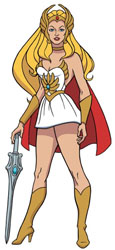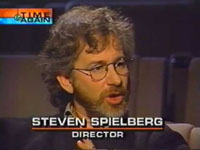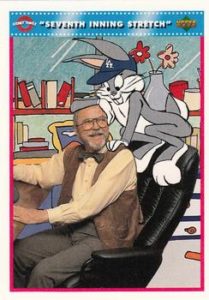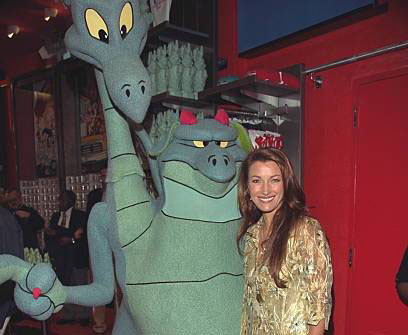Animaniacs Score. Composer Richard Stone oversaw all the music for Animaniacs, Tiny Toon Adventures and Pinky & the Brain. Stone would conduct a full orchestra on the same soundstage that Carl Stalling recorded on for the classic Warner Bros. cartoons and even used Stalling’s piano during sessions.

Richard Stone
“Stalling’s cartoons were a lot more visually oriented, whereas ours are script oriented. He had a lot more sight gags, whereas we go for a lot more satire of movies, TV shows and musicals. As a result, we’re constantly hopping across styles. We go from rock’n’roll to country to Broadway to classical. It’s the broadest musical palette you could ever imagine.
“(Producer Steven) Spielberg was a fan of the old cartoons and wanted to create some animation that would last the same way. I always record with an orchestra of real instruments. I purposely shy away from electronics because the rest of pop culture is totally electronic. I want a warmer, more emotional sound. So, at our sessions, nothing plugs in.”
Remembering Eric Larson. In October 1988, animator Andreas Deja was interviewed in the Los Angeles Times about the recent passing of one of Disney’s Nine Old Men, Eric Larson. Andreas said, “He was the best animation teacher ever. You can argue that Disney had better animators but no one was more concerned with passing on the legacy than Eric. When I got hired at Disney, the new animators had to do a four to eight week test with Eric. It was an incredibly stressful time. You were in the place where they had done Peter Pan and Fantasia and you had to show you could work at that level.
“Eric was an incredibly gentle and patient teacher who could deal with that stress and bring you back to the basics. I’m sure that I and several others would have freaked out without his guidance.”

Eric Larson
Ed Grimley. From L.A. Life (Daily News) May 29, 1989: “The Hanna-Barbera production offices have been deluged with letters since NBC announced that Martin Short’s Saturday morning animated show The Completely Mental Misadventures of Ed Grimley won’t be back next season. The team was most impressed with the letters received from 60 Navajo children from the St. Bonaventure Indian Mission reservation in Thoreau, New Mexico. The kids sent in photos of themselves done up as Ed Grimley look-alikes – down to the unicornlike cowlick. For a treat, Hanna-Barbera has sent animator Scott Hill to the reservation to teach the kids how animation works.”
 She-Ra. From Entertainment Weekly May 25th, 2018, Noelle Stevenson, executive producer for the Netflix She-Ra and Princesses of Power said, “I was always looking for the female characters in sci-fi and fantasy who were more than just the girlfriend. I love the female characters in She-Ra. She-Ra was ahead of its time. I’m so excited to bring these stories of female power and love and friendship back now when it seems like we need them more than ever.”
She-Ra. From Entertainment Weekly May 25th, 2018, Noelle Stevenson, executive producer for the Netflix She-Ra and Princesses of Power said, “I was always looking for the female characters in sci-fi and fantasy who were more than just the girlfriend. I love the female characters in She-Ra. She-Ra was ahead of its time. I’m so excited to bring these stories of female power and love and friendship back now when it seems like we need them more than ever.”
 Disney’s Unmade Catcher in the Rye. In Variety July 18th, 1985, it was mentioned that Disney was developing a full length animation project based on J.D. Salinger’s novel The Catcher in the Rye. “Producer Joe Hale confirmed the studio gave Catcher a brief whirl but ultimately backed away when faced with the inevitable legal task of asking Salinger for the right to turn his characters into animated canines. Salinger’s central Holden Caufield character said Hale, was envisioned as ‘a gangly teenage German shepherd type’.”
Disney’s Unmade Catcher in the Rye. In Variety July 18th, 1985, it was mentioned that Disney was developing a full length animation project based on J.D. Salinger’s novel The Catcher in the Rye. “Producer Joe Hale confirmed the studio gave Catcher a brief whirl but ultimately backed away when faced with the inevitable legal task of asking Salinger for the right to turn his characters into animated canines. Salinger’s central Holden Caufield character said Hale, was envisioned as ‘a gangly teenage German shepherd type’.”
 Spielberg on Animation. In the New York Times May 16, 1991, producer Steven Spielberg said, “What we have already discovered and what other studios will discover is that there is not exactly an army of animators waiting for employment but a complete shortage. Within their own little world, they are beginning to attain the status of Kevin Costner and Julia Roberts and studios are starting to steal from studios.
Spielberg on Animation. In the New York Times May 16, 1991, producer Steven Spielberg said, “What we have already discovered and what other studios will discover is that there is not exactly an army of animators waiting for employment but a complete shortage. Within their own little world, they are beginning to attain the status of Kevin Costner and Julia Roberts and studios are starting to steal from studios.
“In the golden era, every studio had an animation department. There’s no limit to it unless bad stories and bad animation resurface because of economic pressure.”
 The Comic Ball Cards. Chuck Jones Productions did Comic Ball trading cards (from Upper Deck Company) of the Looney Tunes characters in 1990 in baseball-themed stories wearing Major League Baseball logos and uniforms. According to the publicity release, Chuck Jones himself wrote and illustrated the cards. He supposedly did more than 800 drawings, 594 of which were used on the cards that were introduced at the Toy Fair in New York in early 1990.
The Comic Ball Cards. Chuck Jones Productions did Comic Ball trading cards (from Upper Deck Company) of the Looney Tunes characters in 1990 in baseball-themed stories wearing Major League Baseball logos and uniforms. According to the publicity release, Chuck Jones himself wrote and illustrated the cards. He supposedly did more than 800 drawings, 594 of which were used on the cards that were introduced at the Toy Fair in New York in early 1990.
The idea for the cards came from the suceess of the 1989’s Bugs Bunny 50th anniversary promotions. When the concept was brought to Jones, he originally said, “I don’t do comic books”. He did agree to do sequential drawings just as he would for an animated cartoon and the hope was that they would eventually be turned over to animators to animate them to be shown on screens at baseball parks.
 The Wisdom of Groening. From The Comics Journal April 1991, The Simpsons’ Matt Groening said, “The Simpsons is deceptively simple. In general, there’s a skeptical look at people in positions of authority, and there’s an underlying message that maybe the people who are telling you what do don’t always have your best interests in mind. Animation lends itself to a lot of easy shots at people and we don’t dwell on anything so people who might otherwise get outraged at what we do are too busy waiting for the next joke. It’s hard to anticipate what will offend someone, but it’s amazing what does.”
The Wisdom of Groening. From The Comics Journal April 1991, The Simpsons’ Matt Groening said, “The Simpsons is deceptively simple. In general, there’s a skeptical look at people in positions of authority, and there’s an underlying message that maybe the people who are telling you what do don’t always have your best interests in mind. Animation lends itself to a lot of easy shots at people and we don’t dwell on anything so people who might otherwise get outraged at what we do are too busy waiting for the next joke. It’s hard to anticipate what will offend someone, but it’s amazing what does.”
Jane Seymour. In the Daily News January 3rd, 1999, actress Jane Seymour who provided the voice for Lady Juliana in Warner Bros. Quest for Camelot (1998) explained why she did it. “The pay is almost nothing. It’s almost a joke. You do it because you want to do something your kids will want to see. It’s fun to do something that they can watch and enjoy and they love it when they recognize my voice.”



 Jim Korkis is an internationally respected animation historian who in recent years has devoted his attention to the many worlds of Disney. He was a columnist for a variety of animation magazines. With his former writing partner, John Cawley, he authored several animation related books including The Encyclopedia of Cartoon Superstars, How to Create Animation, Cartoon Confidential and Get Animated’s Animation Art Buyer’s Guide. He taught animation classes at the Disney Institute in Florida as well as instructing classes on acting and animation history for Disney Feature Animation: Florida.
Jim Korkis is an internationally respected animation historian who in recent years has devoted his attention to the many worlds of Disney. He was a columnist for a variety of animation magazines. With his former writing partner, John Cawley, he authored several animation related books including The Encyclopedia of Cartoon Superstars, How to Create Animation, Cartoon Confidential and Get Animated’s Animation Art Buyer’s Guide. He taught animation classes at the Disney Institute in Florida as well as instructing classes on acting and animation history for Disney Feature Animation: Florida.




















































A Disney Catcher in the Rye would have been unintentionally hilarious. Of course it would be a musical. Can you imagine Holden Caulfield, “a gangly teenage German shepherd type” singing “They’re all phonies…”
Thus be forever grateful to OLIVER AND COMPANY
At least it didn’t give Furries another reason to be who they are thanks to a Disney flick.
I’m actually glad that the Mouse didn’t do Salinger (imagine the controversy if you include Mark David Chapman)
Salinger never would have sold it to anyone, and certainly not to Disney. The first chapter of the book mentions Holden Caulfield’s hatred of movies specifically. Anyone who hated what they ended up doing to Victor Hugo would have stormed the magic kingdom with torches and pitchforks for DISNEY’S THE CATCHER IN THE RYE. I imagine Holden’s big solo would have gone a little something like this:
You’re a phony
A phony-baloney
Saying things
That you know aren’t true.
You’re a phony
Like Kraft macaroni
And the cheese
That has the same stuff
That’s in glue!
And since it has the word “catcher” in its name, they would have felt obligated to eighties it up with baseball jokes and CHEERS references.
As one who plays piano (or tries to), this was especially funtastick! Thank YOO!!
“attain the status of Kevin Costner”
Back when that was a compliment, I guess.
Am I the only person who has noticed that the new She-Ra is even more despised than the original?
I think the new one is mostly despised by older fans that aren’t happy with the changes. Although, to be honest, the original Filmation show (along with it’s brother) wasn’t a strongly written show to begin with. Actually, there were some toys shows that had better writing (believe it or not).
I’ve wondered if the Warners soundstage where Stalling recorded still exists? It did in 1997 apparently, which is really neat that Stone used it to record, but is it still there? And was this the main soundstage where they recorded all of the scores for feature length films too?
I love that Stone even used Stalling’s piano, very cool.
I personally prefer the theratrics myself Chris with all due respect..1930-1969, even the 1929 pilot BOSKO THE TALK-INK KID (only 3 minutes long!) that Harman-Ising did to ANIM.